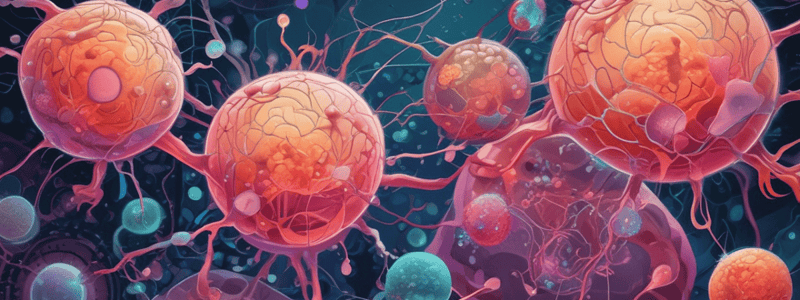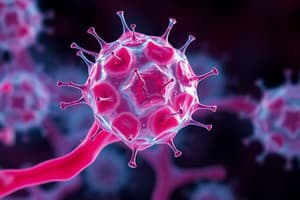Podcast
Questions and Answers
What is the role of CBFA1/RUNX2 in the differentiation of chondrocytes?
What is the role of CBFA1/RUNX2 in the differentiation of chondrocytes?
- It inhibits the differentiation of chondrocytes.
- It induces the expression of osteoprotegerin (OPG).
- It is involved in the regulation of osteoclast differentiation.
- It plays a role in the further differentiation of chondrocytes. (correct)
What is the consequence of mutations in ACVR1/ALK2, a bone morphogenic protein (BMP) type 1 receptor?
What is the consequence of mutations in ACVR1/ALK2, a bone morphogenic protein (BMP) type 1 receptor?
- Fibrodysplasia ossificans progressive (FOP) with autosomal dominant inheritance. (correct)
- Fibrodysplasia ossificans progressive (FOP) with autosomal recessive inheritance.
- Osteoporosis with autosomal dominant inheritance.
- Osteopetrosis with autosomal recessive inheritance.
What is the function of osteoprotegerin (OPG) in the regulation of osteoclast differentiation?
What is the function of osteoprotegerin (OPG) in the regulation of osteoclast differentiation?
- It acts as a receptor for RANKL.
- It is involved in the regulation of osteoblast differentiation.
- It is a decoy receptor for RANKL. (correct)
- It is a ligand for RANK.
What is the consequence of activating LRP5?
What is the consequence of activating LRP5?
What is a potential downside of using MSCs in research and therapy?
What is a potential downside of using MSCs in research and therapy?
Flashcards are hidden until you start studying
Study Notes
Mesenchymal Stem Cells (MSCs)
- Multipotent progenitor cells residing in bone marrow, adipose tissue, and cord blood
- Undifferentiated and self-renewable, with the ability to differentiate into three lineages: bone, cartilage, and adipose
- Identified by expression of CD105, CD90, and CD73, and lack of CD34
MSC Differentiation
- Can differentiate into osteocytes, chondrocytes, and adipocytes in vivo
- Can also trans-differentiate into ectodermal and endodermal cells, although this is controversial in vivo
Bone Development
- Osteoprogenitor cells, osteoblasts, bone surface lining cells, and osteocytes are derived from MSCs
- Osteoclasts are derived from monocytes (hematopoietic stem cells)
- RUNX2 is a key transcription factor for osteoblastic lineage
- RANKL is produced by osteoblasts and is essential for osteoclast maturation
Signal Transduction Pathways
- BMP and WNT are important for bone development
- WNT/b-catenin inhibits and promotes osteogenic differentiation
- WNT regulates OPG synthesis, which blocks osteoclast differentiation
- CBFA1/RUNX2 regulates osteoblastic and chondrocytic differentiation
MSC in Research and Medicine
- MSCs are easy to obtain and can be differentiated in vitro
- Can be transfected with foreign DNA and frozen for later use
- Used for tissue repair, immunosuppression, and studying differentiation pathways
The Dark Side of MSCs
- MSCs can become sarcomas, a potential downside
Studying That Suits You
Use AI to generate personalized quizzes and flashcards to suit your learning preferences.




